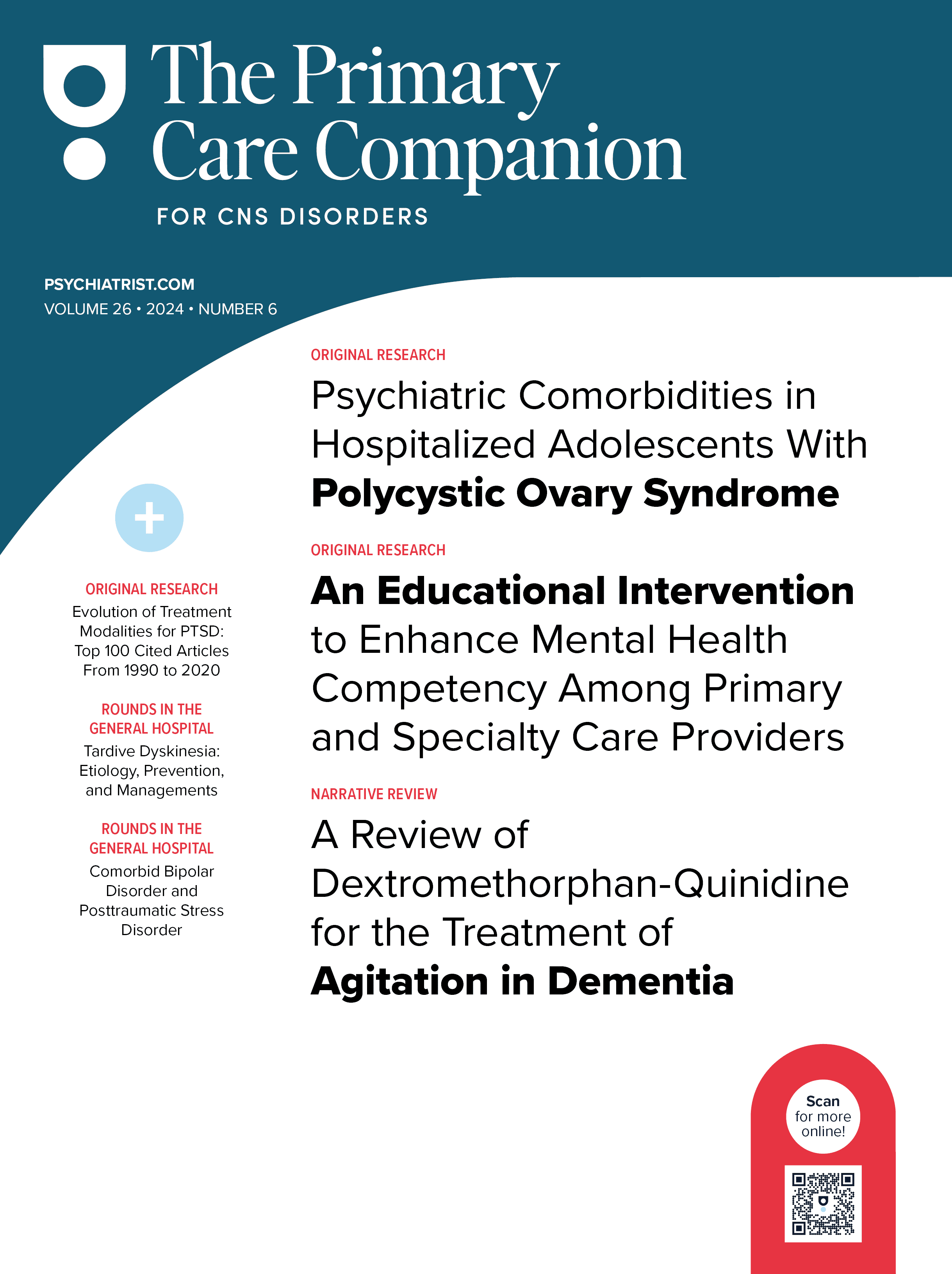Posttraumatic stress disorder (PTSD) is a debilitating condition occurring after a traumatic event. Domain features include intrusive symptoms, avoidance behaviors, negative cognitive alterations, and marked hyperarousal symptoms.1,2 Sleep disturbance is notoriously difficult to resolve and may include trauma-related nightmares.2,3 Dysregulation in noradrenergic signaling during sleep has been hypothesized to cause nightmares.4 α-Antagonists may reduce symptoms of PTSD, including nightmares, by blunting norepinephrine’s effects. Of the α-antagonists, prazosin has the most data and is hypothesized to penetrate the blood-brain barrier given its high lipophilicity.5–9 While some studies suggest that higher doses of prazosin (ie, ≥ 30 mg daily) are needed to achieve sufficient response, tolerability issues may arise, particularly dizziness and hypotension.10 Little evidence exists to delineate the role of alternative α1-antagonists in PTSD.
Terazosin is an α1-antagonist with minimal effects on α2.11 While terazosin is less lipophilic than prazosin, data from Parkinson disease research suggest that terazosin may in fact cross the blood-brain barrier.12,13 Although use of terazosin in treatment of trauma-related nightmares is not currently supported by major clinical guidelines, previous reports have described successful use.14,15 A recent retrospective study of treatments for PTSD described higher rates of treatment response with terazosin compared to prazosin.16 Terazosin also had higher rates of treatment response than many of the agents described including quetiapine, aripiprazole, trazodone, mirtazapine, and the combinations of prazosin with trazodone or quetiapine.16 The longer half-life of terazosin (12 hours) compared to prazosin (2 to 3 hours) may provide further advantage, which other trials using prazosin attempted to overcome with divided doses to target daytime symptoms, such as hyperarousal and flashbacks.10,17,18 Terazosin may have a more sustained effect on daytime symptoms and may allow for less frequent dosing than prazosin. We present a case in which terazosin was successfully utilized to treat trauma-related nightmares after a failed trial of prazosin.
Case Report
A 53-year-old woman was referred to the psychiatry clinic for treatment of PTSD, major depressive disorder, and borderline personality disorder. She reported a personal history of trauma including sexual, physical, and emotional abuse and abandonment from childhood through adulthood. Predominant PTSD symptoms included nightmares (approximately 5 nights/week), hypervigilance, flashbacks, altered mood, and interpersonal conflict and volatility. She had previously completed dialectical behavioral therapy and was chronically taking venlafaxine 300 mg once daily, aripiprazole 10 mg once daily, gabapentin 100 mg once daily, and lorazepam 2 mg as needed for severe PTSD symptoms. She previously trialed prazosin up to a dose of 10 mg once daily over 6 years, and prior to prazosin had not trialed any other agents for PTSD-related nightmares. She noted initial improvement in hypervigilance, reduction in nightmare frequency from 5 nights/week to 1 night/week, and reduced nightmare content recall upon awakening. She later noted loss of efficacy and possible side effects of malaise and edema, which resolved after discontinuing prazosin. Nightmares returned, and she was prescribed terazosin 2 mg nightly, which was titrated to 4 mg nightly.
With terazosin 4 mg, nightmares nearly resolved, occurring only occasionally. After 1 year of stability, she reported increased psychosocial stressors contributing to decreased sleep quality and increased nightmare frequency. Terazosin was increased to 5 mg once nightly, resulting in improved sleep quality, nightmare resolution, and reduced feelings of hypervigilance. During this 3-year treatment period, she has not experienced any adverse effects, blood pressure and heart rate have remained within normal limits, and she was able to discontinue lorazepam.
Discussion
In this case, after a failed trial of prazosin due to concerns regarding tolerability and loss of efficacy, a switch to terazosin was efficacious in reducing the severity and frequency of trauma-related nightmares, feelings of hypervigilance, and frequency of flashbacks in a patient with PTSD. Unfortunately, formal scales commonly used to measure PTSD severity including the Clinician-Administered PTSD Scale,19 PTSD Checklist,20 and Clinical Global Impressions21 were unable to be utilized, as the patient endorsed concerns surrounding re-experiencing symptoms when completing questions and was unwilling to participate in completion of any formal scales. For this reason, changes in PTSD symptoms were gathered only through subjective descriptions. Improvement in nightmares aligned with initiation of terazosin and subsequent dose increases with no adverse effects. Thus, terazosin may assist in the treatment of trauma-related nightmares, especially when prazosin is not effective or tolerated. Additional studies are warranted to determine comparative efficacy and tolerability of the α-antagonists in PTSD.
Article Information
Published Online: March 5, 2024.
https://doi.org/10.4088/PCC.23cr03638
© 2024 Physicians Postgraduate Press, Inc.
Submitted: September 2, 2023; accepted: November 20, 2023.
To Cite: White RT, Armijo CJ, Elmaoued AA. Use of terazosin to treat trauma-related nightmares after a failed trial of prazosin. Prim Care Companion CNS Disord. 2024;26(2):23cr03638.
Author Affiliations: University of South Florida Taneja College of Pharmacy, Tampa, Florida (White); University of New Mexico School of Medicine, Albuquerque, New Mexico (Armijo); University of New Mexico College of Pharmacy, Albuquerque, New Mexico (Elmaoued).
Corresponding Author: Amre Elmaoued, PharmD, 2600 Marble Avenue, Albuquerque, NM 87106 ([email protected]).
Relevant Financial Relationships: None.
Funding/Support: None.
Additional Information: Information has been de-identified to protect patient anonymity.
References (21)

- Trauma- and Stressor-Related Disorders. In: Diagnostic and Statistical Manual of Mental Disorders. DSM Library. American Psychiatric Association Publishing; 2022.
- Kirkpatrick HA, Heller GM. Posttraumatic stress disorder: theory and treatment update. Int J Psychiatry Med. 2014;47(4):337–346. PubMed CrossRef
- DeViva JC, Zayfert C, Pigeon WR, et al. Treatment of residual insomnia after CBT for PTSD: case studies. J Trauma Stress. 2005;18(2):155–159. PubMed CrossRef
- Hendrickson RC, Raskind MA. Noradrenergic dysregulation in the pathophysiology of PTSD. Exp Neurol. 2016;284(Pt B):181–195. PubMed CrossRef
- Miller LJ. Prazosin for the treatment of posttraumatic stress disorder sleep disturbances. Pharmacotherapy. 2008;28(5):656–666. PubMed CrossRef
- Zhang Y, Ren R, Sanford LD, et al. The effects of prazosin on sleep disturbances in posttraumatic stress disorder: a systematic review and meta-analysis. Sleep Med. 2020;67:225–231. PubMed CrossRef
- Raskind MA, Peterson K, Williams T, et al. A trial of prazosin for combat trauma PTSD with nightmares in active-duty soldiers returned from Iraq and Afghanistan. Am J Psychiatry. 2013;170(9):1003–1010. PubMed CrossRef
- Raskind MA, Peskind ER, Chow B, et al. Trial of prazosin for posttraumatic stress disorder in military veterans. N Engl J Med. 2018;378(6):507–517. PubMed CrossRef
- Raskind MA, Peskind ER, Kanter ED, et al. Reduction of nightmares and other PTSD symptoms in combat veterans by prazosin: a placebo-controlled study. Am J Psychiatry. 2003;160(2):371–373. PubMed CrossRef
- Koola MM, Varghese SP, Fawcett JA. High-dose prazosin for the treatment of posttraumatic stress disorder. Ther Adv Psychopharmacol. 2014;4(1):43–47. PubMed CrossRef
- Terazosin: Drug information–UpToDate. Accessed May 11, 2023. https://www.uptodate.com/contents/table-of-contents/drug-information/general-drug-information
- Achari R, Laddu A. Terazosin: a new alpha adrenoceptor blocking drug. J Clin Pharmacol. 1992;32(6):520–523. PubMed CrossRef
- Cai R, Zhang Y, Simmering JE, et al. Enhancing glycolysis attenuates Parkinson’s disease progression in models and clinical databases. J Clin Invest. 2019;129(10):4539–4549. PubMed CrossRef
- Salviati M, Pallagrosi M, Valeriani G, et al. On the role of noradrenergic system in PTSD and related sleep disturbances. The use of terazosin in PTSD-related nightmares: a case report. Clin Ter. 2013;164(2):133–137. PubMed. 10.7417/CT.2013.1532
- Nirmalani-Gandhy A, Sanchez D, Catalano G. Terazosin for the treatment of trauma-related nightmares: a report of 4 cases. Clin Neuropharmacol. 2015;38(3):109–111. PubMed CrossRef
- Detweiler MB, Pagadala B, Candelario J, et al. Treatment of posttraumatic stress disorder nightmares at a Veterans Affairs medical center. J Clin Med. 2016;5(12):117. PubMed CrossRef
- Terazosin Package Insert.pdf. Accessed July 22, 2023. https://www.accessdata.fda.gov/drugsatfda_docs/label/2009/019057s022lbl.pdf
- Minipress Package Insert. Accessed July 22, 2023. https://cdn.pfizer.com/pfizercom/products/uspi_minipress.pdf
- Weathers FW, Bovin MJ, Lee DJ, et al. The Clinician-Administered PTSD Scale for DSM-5 (CAPS-5): development and initial psychometric evaluation in military veterans. Psychol Assess. 2018;30(3):383–395. PubMed CrossRef
- Bovin MJ, Marx BP, Weathers FW, et al. Psychometric properties of the PTSD Checklist for Diagnostic and Statistical Manual of Mental Disorders-Fifth Edition (PCL-5) in veterans. Psychol Assess. 2016;28(11):1379–1391. PubMed CrossRef
- Guy W. Clinical Global Impressions. ECDEU Assessment Manual for Psychopharmacology. DHEW Publication No. 76-338. Rockville, MD: National Institute of Mental Health; 1976:217–222.
Please sign in or purchase this PDF for $40.
Save
Cite




